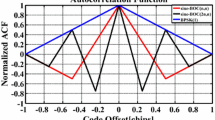Abstract
This paper presents a novel blind frequency offset estimator for coherent M-PSK systems in an autonomous radio. The proposed estimator is based on the spectrum of the signal’s argument. A data removal block is developed. We derive the distribution of the instantaneous phase, which is applied to indicate that the proposed estimator can be considered as a class of nonlinear least-squares estimator. We provide a method to analyze the asymptotic performance of the proposed estimator. This enable us to predict the mean-square error on frequency offset estimation for all signal-to-noise ratio (SNR) values. Computer simulations indicate that the proposed estimator achieves better performance than the original estimator. The performance of the proposed estimator as a blind estimator is also illustrated.








Similar content being viewed by others
References
C. Candan, A method for fine resolution frequency estimation from three DFT samples. IEEE Signal Process. Lett. 18(6), 351–354 (2011)
Y.W. Cao, S. Yu, J. Shen, W.Y. Gu, Y.F. Ji, Frequency estimation for optical coherent MPSK system without removing modulated data phase. IEEE Photonics Technol. Lett. 22(10), 691–693 (2010)
H.B. Celebi, H.B. Arslan, A joint blind carrier frequency and phase offset detector and modulation order identifier for MPSK signals, in IEEE Radio and Wireless Symposium 2010, New Orleans, USA, January (2010), pp. 348–351
W. Dai, Y.Z. Wang, J. Wang, Joint power estimation and modulation classification using second- and higher statistics, in IEEE Wireless Communications and Networking Conference, Orlando, USA, March (2002), pp. 155–158
L.F. Han, Y. Guo, Y.B. Shang, A QPSK carrier estimation method based on modified FFT, in 2009 5th International Conference on Wireless Communications, Networking and Mobile Computing, Beijing, China, September (2009), pp. 397–400
Y.L. Huang, Q. Yuan, Y.R. Lu, Carrier frequency offset estimation based on the wrapped phase entropy, in IEEE International Conference on Communications (ICC 2008), Beijing, China, May (2008), pp. 936–940
E. Jacobsen, P. Kootsookos, Fast, accurate frequency estimators. IEEE Signal Process. Mag. 24(3), 123–125 (2007)
F. Mazzenga, G.E. Corazza, Blind least-squares estimation of carrier phase, doppler shift, and doppler rate for m-PSK burst transmission. IEEE Commun. Lett. 2(3), 73–75 (1998)
U. Mengali, M. Morelli, Data-aided frequency estimation for burst digital transmission. IEEE Trans. Commun. 45(1), 23–25 (1997)
M. Pedzisz, A. Coatanhay, Minimum entropy approach for carrier frequency recovery. IEEE Trans. Wirel. Commun. 5(4), 774–778 (2006)
D.C. Rife, R.R. Boorstyn, Single-tone parameter estimation from discrete-time observations. IEEE Trans. Inf. Theory 20(5), 591–598 (1974)
M. Simon, J. Hamkins, Autonomous Software-defined Radio Receivers for Deep Space Applications (Wiley, New York, 2006)
D. Taich, I. Bar-David, Maximum-likelihood estimation of phase and frequency of MPSK signals. IEEE Trans. Inf. Theory 45(7), 2652–2655 (1999)
D.N. Vizireanu, A fast, simple and accurate time-varying frequency estimation method for single-phase electric power systems. Measurement 45(5), 1331–1333 (2012)
D.N. Vizireanu, S.V. Halunga, Analytical formula for three points sinusoidal signals amplitude estimation errors. Int. J. Electron. 99(1), 149–151 (2012)
S.V. Vizireanu, S.V. Halunga, Single sine wave parameters estimation method based on four equally spaced samples. Int. J. Electron. 98(7), 941–948 (2011)
D.N. Vizireanu, S.V. Halunga, Simple, fast and accurate eight points amplitude estimation method of sinusoidal signals for DSP based instrumentation. J. Instrum. 7(4), 1–10 (2012)
A.J. Viterbi, A.M. Viterbi, Non-linear estimation of PSK-modulated carrier phase with application to burst digital transmission. IEEE Trans. Inf. Theory 29(4), 543–551 (1983)
Y. Wang, E. Serpedin, P. Ciblat, Optimal blind carrier recovery for MPSK burst transmissions. IEEE Trans. Commun. 51(9), 1571–1581 (2003)
T. Yucek, H. Arslan, Spectrum characterization for opportunistic cognitive radio systems, in Military Communications Conference 2006, Washington, D.C., USA, October (2006), pp. 2757–2762
X. Zhou, X. Chen, K.P. Long, Wide-range frequency offset estimation algorithm for optical coherent systems using training sequence. IEEE Photonics Technol. Lett. 24(1), 82–84 (2012)
Acknowledgements
This research was supported by National High Technology Research and Development Program of China (Grant No. 2011AA7014053).
Author information
Authors and Affiliations
Corresponding author
Appendix
Appendix
We assume that
where x and y are equal to q R and q I , respectively. The joint probability of x and y is given by
In order to simplify the derivation, we divide the range of z into three parts. Thus, we can write the expression of p(z) as follows:
We derive the p 2(z) and the other two use the same method. From (16), we obtain
According to (17) and (18), p 2(z) can be written as
where

Then, we get
Derive p 1(z) and p 3(z) following the same method, we get the same expression as p 2(z). Thus,

Let
z(n) is not the stationary process, and the values of E 1 and E 2 can be computed through p(z). Let m=2D; we get


where
In order to compute the integrals in (20) and (21), we extend p(z) into Fourier series, which can be written as
with the Fourier series coefficients [10]
where I i (⋅) is the first kind modified Bessel function of order i. The integrals of E 1 and E 2 become integrable.
According to (16), we get

where sum(E 2 ) is sum of all the elements in E 2 .
Rights and permissions
About this article
Cite this article
Wang, L., Wang, Z. & Xiong, W. A Blind Frequency Offset Estimator for Coherent M-PSK System in Autonomous Radio. Circuits Syst Signal Process 32, 1205–1217 (2013). https://doi.org/10.1007/s00034-012-9494-y
Received:
Revised:
Published:
Issue Date:
DOI: https://doi.org/10.1007/s00034-012-9494-y




